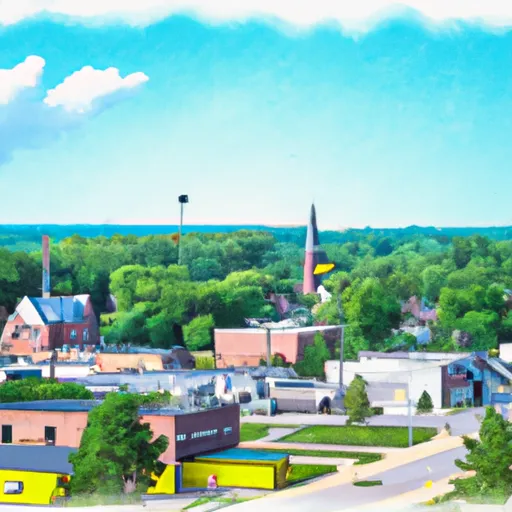-
 Snoflo Premium
Snoflo Premium
Get unlimited access to all our content
With no Ad interruptions! - Start Your Free Trial Login with existing account
Lupton
Eden Index
Climate
6.1
•
Recreation
4.2
•
Community
•
Safeguard
3.9/10

Lupton, Michigan is a small community located in Ogemaw County, in the northern part of the state. The region experiences a humid continental climate, characterized by cold winters with heavy snowfall and warm summers. The average annual precipitation is around 34 inches, with rain occurring throughout the year. The area is also known for its beautiful forests, including the Huron National Forest, which covers a significant portion of the county.
Lupton is blessed with several lakes and rivers, making it a great place for outdoor enthusiasts. The Rifle River, which runs through the area, offers opportunities for fishing, kayaking, and canoeing. It is known for its trout and salmon populations, attracting anglers from far and wide. The area is also home to numerous smaller lakes, providing tranquil spots for boating, swimming, and picnicking. In the winter, the region transforms into a haven for snowmobiling and cross-country skiing, with many trails available.
Overall, Lupton, Michigan, with its diverse climate and abundant water resources, offers a range of outdoor recreational opportunities, allowing visitors and residents to connect with nature throughout the year.
What is the Eden Index?
The Snoflo Eden Index serves as a comprehensive rating system for regions, evaluating their desirability through a holistic assessment of climate health, outdoor recreation opportunities, and natural disaster risk, acknowledging the profound impact of these factors on livability and well-being.
Climate Health Indicator (CHI): 6.1
Lupton receives approximately
774mm of rain per year,
with humidity levels near 82%
and air temperatures averaging around
7°C.
Lupton has a plant hardyness factor of
4, meaning
plants and agriculture in this region thrive during a short period during spring and early summer. Most
plants will die off during the colder winter months.
By considering the ideal temperature range, reliable water supplies, clean air, and stable seasonal rain or snowpacks, the Climate Health Indicator (CHI) underscores the significance of a healthy climate as the foundation for quality living.
A healthy climate is paramount for ensuring a high quality of life and livability in a region, fostering both physical well-being and environmental harmony. This can be characterized by ideal temperatures, reliable access to water supplies, clean air, and consistent seasonal rain or snowpacks.
Weather Forecast
Streamflow Conditions
Southwestern Lake Huron
Area Rivers
Southwestern Lake Huron
Snowpack Depths
Southwestern Lake Huron
Reservoir Storage Capacity
Southwestern Lake Huron
Groundwater Levels
Recreational Opportunity Index (ROI): 4.2
The Recreational Opportunity Index (ROI) recognizes the value of outdoor recreational options, such as parks, hiking trails, camping sites, and fishing spots, while acknowledging that climate plays a pivotal role in ensuring the comfort and consistency of these experiences.
Access to outdoor recreational opportunities, encompassing activities such as parks, hiking, camping, and fishing, is crucial for overall well-being, and the climate plays a pivotal role in enabling and enhancing these experiences, ensuring that individuals can engage in nature-based activities comfortably and consistently.
Camping Areas
| Campground | Campsites | Reservations | Toilets | Showers | Elevation |
|---|---|---|---|---|---|
| Green Lake - Waterloo State Rec Area | None | 959 ft | |||
| DeTour - Lake Superior State Forest | 21 | 592 ft | |||
| Bishop Lake - Brighton Rec Area | None | 901 ft | |||
| Pinckney State Rec Area | 235 | 907 ft | |||
| Murray Lake - Brighton Rec Area | None | 875 ft | |||
| Appleton Lake - Brighton Rec Area | None | 888 ft | |||
| Sugarloaf Lake - Waterloo State Rec Area | None | 961 ft |
Catastrophe Safeguard Index (CSI):
The Catastrophe Safeguard Index (CSI) recognizes that natural disaster risk, encompassing floods, fires, hurricanes, and tornadoes, can drastically affect safety and the overall appeal of an area.
The level of natural disaster risk in a region significantly affects safety and the overall livability, with climate change amplifying these risks by potentially increasing the frequency and intensity of events like floods, fires, hurricanes, and tornadoes, thereby posing substantial challenges to community resilience and well-being.
Community Resilience Indicator (CRI):
The Community Resilience Indicator (CRI) recognizes that education, healthcare, and socioeconomics are crucial to the well-being of a region. The CRI acknowledges the profound impact of these elements on residents' overall quality of life. By evaluating educational resources, healthcare accessibility, and economic inclusivity, the index captures the essential aspects that contribute to a thriving community, fostering resident satisfaction, equity, and social cohesion.

